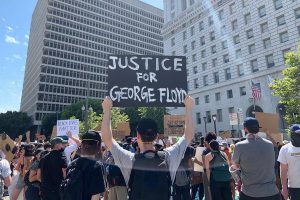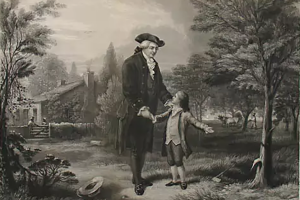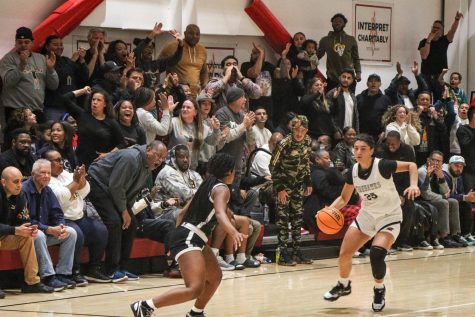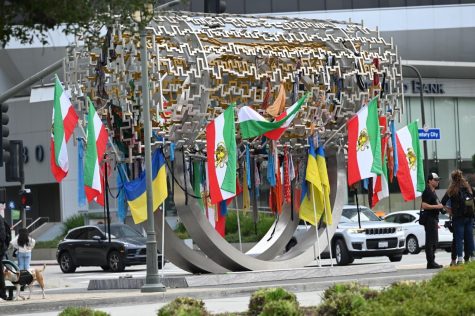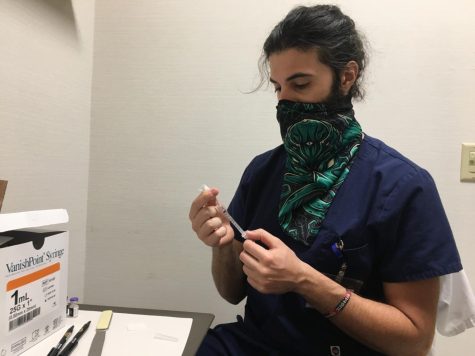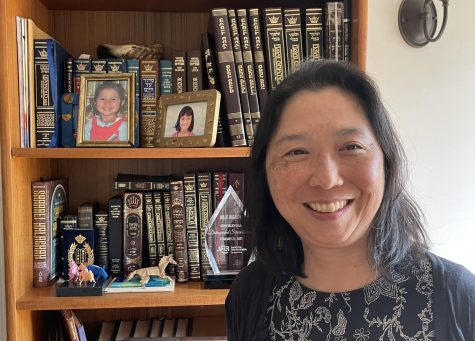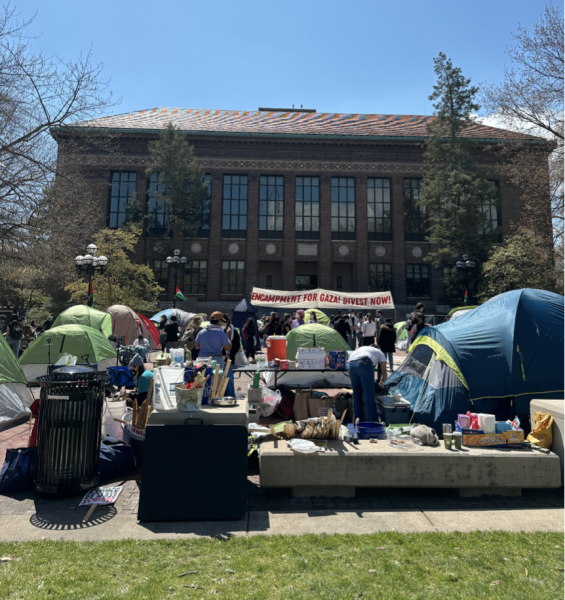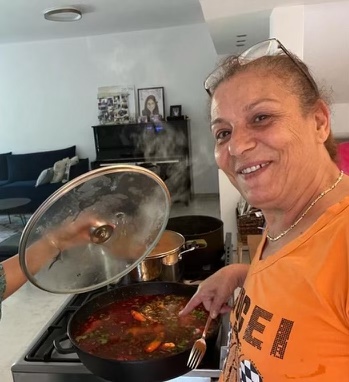Two days after rioters invade U.S. Capitol, Town Hall seeks lessons through questions
ABHORRED: In video shown Feb. 9 at former President Trump’s impeachment trial, his supporters shouted “No Trump, no peace!” as they marched up the Capitol steps Jan. 6 hoping to stop the certifying of electoral votes from the November election. Shalhevet students were unanimous in condemning the action.
Editors’ Note: Because of the national climate of violence surrounding this issue, and to ensure the safety of students and their willingness to speak at Town Hall, this story gives only the first name, last initial and grade level of students quoted. Our intention is for members of the Shalhevet community to be able to identify one another without exposing students to attacks on the internet or elsewhere.
About 48 hours after rioters raised havoc at the U.S. Capitol Jan. 6, students from across the spectrum of political views held at Shalhevet said they were appalled by it.
At Town Hall that Friday morning, everyone who spoke, including Trump supporters, said they found the event abhorrent. Some believed Trump had incited it, and a few thought that last spring’s Black Lives Matter protests had caused more damage. Several teachers weighed in with commentary about what could be learned.
Led by Agenda Chair Kate Orlanski, the schoolwide discussion briefly reviewed the events, which began when then-president Donald Trump spoke at a “Save America” rally at the Ellipse, a park in front of the White House. In his speech, Trump urged his supporters to march to the Capitol with him to “fight like hell” to “stop the steal” of the November presidential election, which he had lost, by stopping the count of the certification of the 50 states’ electoral votes from the November presidential election, which he had lost.
By midday, the thousands of people who had attended the rally had gathered in front of the Capitol building. A massive swarm of rioters overwhelmed Capitol police barriers, violently attacking officers as well as news crews. They broke into the Senate floor, House floor and Capitol Rotunda, threatening the lives of lawmakers, who were meanwhile being evacuated. Outside they set up a gallows; inside they shouted “Hang Mike Pence!”
When it was over, five people — including Capitol Police officer Brian Sicknick, and a rioter from San Diego who was shot as she climbed through the door to the House while members were still there — had died, and an additional 140 had been injured. Another officer lost consciousness after being pushed into stairs with a metal barrier.
Law enforcement officers were also beaten with flag poles and pipes. One suffered a mild heart attack after being shot with a stun gun multiple times. Other injuries included bruising, fractured ribs, shattered spinal discs, chemical exposure, lasers in the eyes, brain injury, and more.
Sophomore Daniel K. said he was never a fan of President Trump’s behavior or some of the things he would say, but thought he was good for Israel.
“But definitely after he’s been asking his supporters to rally in front of Congress to protest a function of our democracy and then riling them up and then not having a police presence there, I think that kind of killed it for me,” Daniel said. “Because to be honest, it was an assault on everything we stand for.”
Junior Noah M. said that he was never a big Trump supporter but had previously thought that people overrated how bad he was and was annoyed with the constant complaints about him.
“But I think the second this happened two days ago, and how he wasn’t really doing anything about it — almost all respect I had for him kind of just went out the window,” Noah said at the Town Hall. “It’s not fair to the country, it’s not fair to the people who supported you at first, too. I just kind of find it really like, honestly kind of gross.”
Students and teachers expressed opinions about who was to blame for the event, how it could have happened, and how opinions on President Trump had changed. Some also compared the event to the Black Lives Matter protests.
Freshman Kyla Z. said that the riots at the Capitol were completely out of line, but compared the event to the BLM protests.
“I’ve seen a lot of people saying like, ‘Oh the BLM protests were nothing like this’ when that completely destroyed so much more resources, businesses, so much more than this did,” Kyla said. “Both of them are things that shouldn’t happen.”
Senior Noa S. said that when violence was added to the equation in both the BLM protests and the rioting at the Capitol, the violent minority put a bad name on their respective political party as a whole.
“There was a small fraction of people that decided to loot and be violent and that completely put a bad name on the Democratic party,” said Noa. “[The rioting at the Capitol] made the Republican party look bad but the majority of the Republican party is not bad, and that goes for Democrats as well.”
However, junior Bayley S. and sophomore Yael S. did not agree that the BLM protests should be compared to the rioting at the Capitol.
“At their most violent, they never urinated at the Capitol building,” Bailey said.
Yael said that Trump supporters were using the BLM protests as a scapegoat so they could feel better about themselves.
“BLM actually had a cause and BLM was because people are fed up,” said Yael. “They are just so mad at the way they have been treated and all this police brutality and that one [the mob at the Capitol] was just them going in because they’re mad that they lost.”
Junior Kevin C. said that, while the BLM protests and the Capitol riots are distinct events, the BLM protests were a better cause than rioting over Trump losing the election. He said that actions matter, too.
“You can’t just say a good cause can justify bad actions,” said Kevin.
Science teacher Mr. Chris St. Germaine said the attack was evidence that American democracy could be headed for a downfall.
“We read about it, but I don’t think it seems real,” Mr. St. Germaine said. “And now I think we have seen what happens when we have years of certain individuals doing the same thing.”
Saying that everyone was to blame for the event, even if they weren’t physically at the riots, he drew attention to the themes of some of former President Trump’s speeches.
“‘Let’s suppress the media, let’s make everyone believe that everything they hear is fake except what comes from me, I am the only source of truth, I’m the only source of information, I’m the only one that can help you.’”
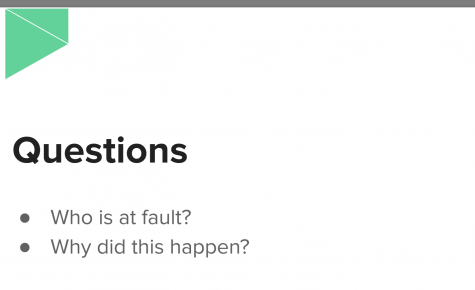
Senior Joey B. said that the invasion of the Capitol was not justified, but felt that disregarding the opinions of many Americans who feel the voting process is corrupt was also wrong. Whether or not President Trump actually won is not the problem, he said, but rather that many Americans have lost faith in the system.
“It’s a question of why did these people do this,” Joey said. “We have to get into the psychology of these individuals and try to understand what they see as the issue is and try to see how to actually fix that issue, or if it exists at all.”
Rabbi David Stein, Interim Director of Judaic Studies, replied to Joey sharing a Gemara in Bava Matzia.
In this Gemara, he said, Rabbi Eliezer tried to prove his opinion was right by having trees uproot themselves and move, the direction of the water in the river switch, the walls of the Beit Midrash fall slanted, and even a heavenly voice come out and say that he was correct.
But the majority still did not accept his opinion. Rabbi Stein went on to quote the view of Rabbi Lord Jonathan Sacks z’’l, a philosopher, author, and former chief rabbi of Britain.
“To kind of borrow Rabbi Sacks’ interpretation of this, that you guys all learned, is that we have a system,” Rabbi Stein said. “We have text, and precedent, and consensus, and that’s how we make decisions.”
“No matter where you are politically, we have a system that we have to use to decide what to do when we have disputes. And storming the Capitol of the United States is never a part of that system. Just as much as looting is not part of that system.”
Rabbi Stein said society falls apart when people go against the system in place and lose faith in it.
“Peaceful protest is part of that system,” said Rabbi Stein. “Impeachment is part of that system. Congressional investigations into collusion are part of that system. But ultimately, if they conclude there is no collusion or they conclude that there was a valid election, voting is part of that system, we have to follow that system.”
Responding to Rabbi Stein, freshman Rami M. said it’s not always easy for everyone to do the right thing and protest peacefully, even though most protests start out peaceful.
And Social Studies teacher Mr. William Reusch said that people have lost faith in the system. He suggested that in order to regain faith, people should try to prove their own ideas wrong, or “seek disconfirmation” in order to see if what they say or believe is actually correct.
That, he said, could overcome the tend “blind spots” in what people say; which causes an inability to recognize when what they are spreading is completely false, or perhaps just short-sighted.
“I think if you apply intellectual humility, genuine curiosity, and grace, then we can go out into the world and try to understand one another better and we can try and get back some of this unity,” Mr. Reusch said.
“The realization that you might be wrong — Intellectual humility,” he said. “Genuine curiosity, like, be actually curious…Like why people see things so differently than you, so ask them…Grace. Just pausing judgment a little bit.”
Following the attack on the Capitol, on Jan. 13 the House passed an Article of Impeachment against president Trump for “incitement of Insurrection.” Although it was supported by both Democrats and Republicans in both the House and Senate — passing 57- 43 in the Senate, with seven Republicans voting to impeach — it failed to win the two-thirds Senate majority that would have been needed to convict.
News Editor Benjamin Gamson contributed to this story.
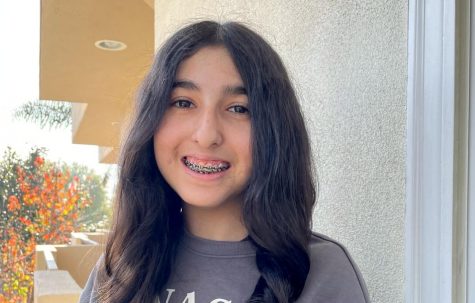
Talia Davoudian, ninth grade, joined the Boiling Point first semester of her freshman year and serves as a staff writer. In her free time, she enjoys archery, jewelry making and spending time with friends and family.


